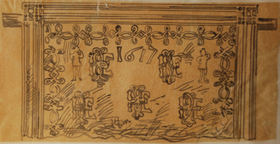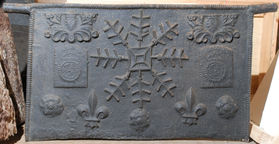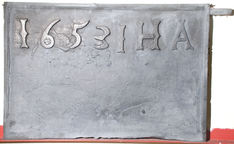-
949
Description: Rectangular; low-relief moulded edging along top, then down sides; double-looped 'lens' pattern stamp repeated six times across the top, inside the edging and, rotated, three times down each side; becapped human figure stamp, with his left arm raised to his head and his right arm akimbo, repeated in each top corner; between these, 'IE' monogram with continuous loop between the letters repeated five times, two in line above and three below, the centre one slightly raised; the date between the top two; a lifting handle on each side.
Notes: Said to have been at Horsham, Sussex; on another fireback, at the Old Manor, Upper Beeding in Sussex, cast with the same stamps, and also dated 1617, the monogram stamp is clearly carved on a 'renaissance' shield, indicating that in this instance the stamps were not impressed as deeply. Drawing by J. Lewis André in the J. Starkie Gardner Collection, Victoria & Albert Museum, Archive of Art and Design (AAD/2014/8). Possibly the fireback referred to by Lewis André in 1882 as belonging to a Miss Alman, of East Street, Horsham (Sussex Archaeological Collections XXXII, p.76).
Inscription: IE 1617 IE / IE IE IE
- Decoration tags:
- rectangular (shape)
- complex individual (edging)
- carved stamps
- individual numbers
- lifting handles
- monogram
- text
- humans
Manufactured: in 1617 in the Weald area of England.
Current location: not known.
Citation: Gardner, J. S., 1898, 'Iron Casting in the Weald', Archaeologia, 56, 1, pp. 133-164.
Citation: Gardner, J. S., 30 Apr 1904, 'An old fire-back' (letter), Country Life, p. 647.
-
131
Description: Rectangular with lifting handles; twisted rope edging (top and sides); elaborate central rope design of concentric squares with eight symmetrical arms each with six branches; two crowned rose en soleil stamps left and right centre; three roses across the bottom interspersed with two fleurs de lys; in top corners, two carved furniture-derived stamps. The width of the main plate is 876mm.
Notes: The rose-en-soleil was the badge of King Edward IV and, thus, a Yorkist symbol. The individual stamps are to be seen, separately or together, on other firebacks, indicating a common source; lifting handles are infrequently encountered on firebacks. The elaborate central rope array may be an interpretation of the escarbuncle, which was the principal heraldic charge on the arms of the Duchy of Cleves (1515-57), possibly associating this fireback with the brief marriage of Henry VIII and Anne of Cleves. Formerly part of the Ade Collection (from Grove Hill, Hellingly, Sussex).
- Decoration tags:
- rectangular (shape)
- rope (edging)
- simple stamps
- carved stamps
- lifting handles
- heraldic
- architectural
- objects
Manufactured: in the mid- to late-16th century possibly at Pounsley Furnace, Framfield in the Weald area of England.
Current location: Hastings Museum and Art Gallery, John's Place, Bohemia Road, Hastings, East Sussex, England.
Museum number: HASMG: 1952.51.44 (part of the Hastings Museum museum group)
-
379
Description: Rectangular; single moulded edge on top and sides; bold date and initials, formed from large individual characters, on same line across full width of plate; otherwise plain. Side lifting lug on top right.
Notes: The style of the numerals, particularly the 6 and 5, can be seen on a smaller fireback of 1656. Lifting handles are only seen on a few firebacks. Formerly part of the J. H. Every collection.
Inscription: 1653 IHA
- Decoration tags:
- rectangular (shape)
- rebated fillet (edging)
- carved stamps
- individual letters
- individual numbers
- lifting handles
- text
Manufactured: in 1653 in the Weald area of England.
Current location: Anne of Cleves House, Southover High Street, Lewes, East Sussex, England.
Museum number: 1944.24.044 (part of the Sussex Archaeological Society museum group)
- Attached to series:
- Date & initials firebacks
- Lifting handle firebacks
- 1650s Wealden series


